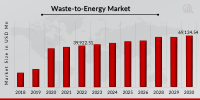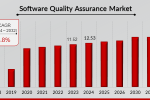(EMAILWIRE.COM, June 30, 2025 ) According to a Comprehensive Research Study by Market Research Future (MRFR), Waste to Energy Market Information By Type, Technology, Application and Region – Forecast till 2030. The Waste to Energy Market industry is projected to grow from USD 39,922.51 Million in 2022 to USD 69,134.54 Million by 2030, exhibiting a compound annual growth rate (CAGR) of 7.23% during the forecast period (2019 – 2030).
The global waste to energy (WTE) market is witnessing significant growth as the demand for sustainable energy and efficient waste management solutions rises across the globe. Waste to energy refers to the process of generating energy in the form of electricity or heat from the primary treatment of waste. It provides a dual benefit by reducing the volume of waste in landfills while simultaneously contributing to energy generation.
Request To Free Sample of Report:
rnhttps://www.marketresearchfuture.com/sample_request/1369
Key Companies:
Veolia
Babcock & Wilcox Enterprises, Inc.
Arrow Ecology Ltd.
Axpo Holding AG
Biogen LTD
Bluefire Renewables
BTA International GMBH
Ramboll
Covanta Holding Corporation
Emery Energy Company
Enerco
Hitachi Zosen Inova AG
VLS Environmental Solutions
Viridor
Wheelabrator Technologies Inc.
Others
Market Dynamics and Growth Drivers
The dynamics of the waste to energy market are shaped by a complex interplay of environmental regulations, energy needs, waste generation rates, and technological advancements. Developed regions such as Europe and North America are at the forefront due to strict environmental laws and aggressive sustainability goals. In contrast, emerging economies in Asia-Pacific, Latin America, and Africa are gradually adopting WTE technologies as part of their urban waste management and energy diversification strategies.
Key Drivers
One of the primary drivers of the waste to energy market is the mounting volume of municipal solid waste. According to the World Bank, global waste generation is expected to increase by 70% by 2050 if current practices continue. This escalation poses significant challenges to traditional waste disposal systems, driving demand for more sustainable alternatives like WTE.
Another important driver is the increasing focus on renewable and alternative energy sources. As countries strive to reduce carbon footprints and dependence on fossil fuels, WTE emerges as a viable solution. In many regions, governments are promoting WTE through incentives, renewable energy credits, and public-private partnerships.
Environmental regulations also play a significant role. Regulations concerning landfill usage, waste reduction targets, and greenhouse gas emissions are encouraging municipalities and industries to invest in WTE technologies. In Europe, for example, the Waste Framework Directive mandates the recovery of energy from waste that cannot be reused or recycled, thus directly supporting market growth.
Waste-to-Energy Market Segmentation
Waste-to-Energy Type of Waste Outlook
Paper
Wood
Food Waste
Plastics
Metals
Others
Waste-to-Energy Technology Outlook
Incineration
Gasification
Pyrolysis
Others
Waste-to-Energy Application Outlook
Electricity Generation
Heat Generation
Transport Fuels
Waste-to-Energy Regional Outlook
North America
US
Canada
Mexico
Europe
Germany
UK
France
Spain
Italy
Russia
Rest of Europe
Asia-Pacific
China
Japan
India
South Korea
Australia
Rest of Asia-Pacific
South America
Brazil
Argentina
Rest of Latin America
Middle East & Africa
Saudi Arabia
UAE
South Africa
Rest of Middle East & Africa
Purchase Complete Report:
rnhttps://www.marketresearchfuture.com/checkout?currency=one_user-USD&report_id=1369
Challenges and Market Constraints
Despite the promising growth, the WTE market faces several challenges. One of the most significant constraints is the high initial investment required for setting up waste to energy facilities. The technology, equipment, and infrastructure demand substantial capital, making it a less attractive option for developing countries with limited budgets.
Public perception and social resistance also pose a hurdle, particularly for incineration plants. Concerns about air pollution, dioxins, and other toxic emissions can lead to community opposition and delays in project execution. Addressing these concerns requires transparency, rigorous environmental standards, and effective communication strategies.
Moreover, the availability of consistent and segregated waste feedstock is critical for the optimal operation of WTE plants. In many regions, poor waste segregation at the source affects the quality and efficiency of energy conversion. Lack of awareness, infrastructure, and incentives for source segregation continue to undermine the full potential of WTE solutions.
Another challenge is the competition from recycling and composting initiatives. In regions with high recycling rates, the volume of non-recyclable waste available for energy recovery may decrease, potentially impacting the economics of WTE plants.
Technological Advancements and Innovation
The waste to energy sector is benefiting from continual innovation in conversion technologies. Traditional incineration has given way to more efficient and less polluting methods such as pyrolysis, gasification, and anaerobic digestion. These advanced thermal and biological processes not only improve energy recovery rates but also minimize environmental impact.
Gasification and pyrolysis, for instance, operate in low-oxygen environments, producing syngas that can be used for electricity generation or as industrial feedstock. These processes generate fewer emissions compared to conventional incineration and are gaining traction in countries with stringent environmental standards.
Anaerobic digestion is another promising technology, especially for organic and food waste. It involves the breakdown of biodegradable material in the absence of oxygen to produce biogas, which can be used for heat or electricity generation. This method is widely adopted in agricultural and food processing industries.
Furthermore, digitization and IoT integration in WTE plants are helping optimize operations, reduce downtime, and improve energy efficiency. Automation and real-time monitoring systems are enabling more precise control over the combustion process, waste input, and energy output.
Browse In-depth Market Research Report:
rnhttps://www.marketresearchfuture.com/reports/waste-to-energy-market-1369
Outlook and Future Trends
The outlook for the global waste to energy market remains positive, with expectations of steady growth in the coming decade. Growth will be primarily driven by urban population expansion, environmental concerns, and supportive policy frameworks.
Future trends in the WTE market will revolve around innovation, decentralization, and sustainability. Decentralized WTE plants, particularly in rural and remote areas, are gaining attention due to lower transmission losses and better alignment with local waste management needs. Modular WTE units are being developed to cater to smaller communities, industrial zones, and commercial complexes.
Related Reports:
Oil Storage Tank Service Market: https://www.marketresearchfuture.com/reports/oil-storage-tank-service-market-30917
Process Piping Market: https://www.marketresearchfuture.com/reports/process-piping-market-30781
Remote Power Panel Market: https://www.marketresearchfuture.com/reports/remote-power-panel-market-31626
Fusion Energy Market: https://www.marketresearchfuture.com/reports/fusion-energy-market-31755







